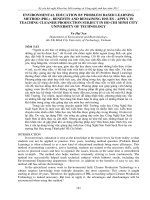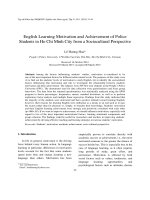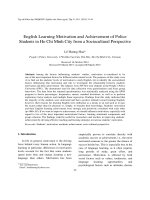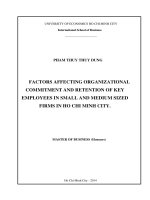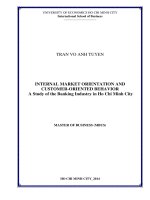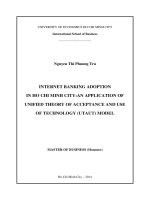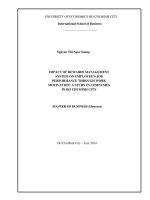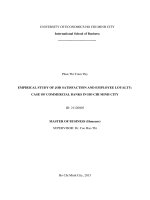Teaching methodologies and learning outcome in ho chi minh city
Bạn đang xem bản rút gọn của tài liệu. Xem và tải ngay bản đầy đủ của tài liệu tại đây (2.8 MB, 220 trang )
Ho Chi Minh City Open University
4th TESOL Conference 2016
Theme:
TEACHING METHODOLOGIES AND
LEARNING OUTCOMES IN HO CHI MINH
CITY
Date:
May 14 2016
Venue:
HCMC Open University
97 Vo Van Tan, District 3, Ho Chi Minh City,
Vietnam
Conference Committee
Assoc. prof. Dr. Nguyen Van Phuc, Patron
Rector of HCMC Open University
Dr. Le Thi Thanh Thu, Chair
Dean of Graduate School – HCMC OU
Dr. Nguyen Thuy Nga, Vice Chair
Dean of Faculty of Foreign Languages – HCMC OU
Dr. Pham Vu Phi Ho, Advisor
Coordinator of MA Program in TESOL – HCMC OU
Proceedings Editors
Dr. Nguyen Thuy Nga
Dr. Pham Vu Phi Ho
ii
Dr. Tran Quoc Thao
Mai Minh Tien
A MESSAGE FROM A CONFERENCE
EXECUTIVE
On behalf of the organizing committee, I
have an honor to welcome all of the
delegates to the 4th HCMC OU TESOL
Conference 2016 at Ho Chi Minh City
Open University. The purpose of the
TESOL Conference is to create a forum for
lecturers and instructors to come and share
their instructional models or experiences in teaching languages in
Ho Chi Minh City areas.
I am delighted to express my deepest thanks to delegates from Sai
Gon University, University of Social Sciences and Humanities,
Suranaree University of Technology, Thailand, Ho Chi Minh City
University of Technology and Education, Assumption University,
Bangkok, Thailand, Banking University of Ho Chi Minh City,
University of Finance – Marketing, Ho Chi Minh City University
of Foreign Languages and Information Technology (HUFLIT),
Tri Viet English Center, Australian Centre for Education and
Training, and of course, delegates from HCMC Open University.
I would like to express my acknowledgement to the two Keynote
speakers, particularly to Prof. Joseph Foley, Director of the PhD
program at Assumption University, in Bangkok, Thailand. Your
valuable knowledge will bring all the delegates of the TESOL
Conference 2016 to a new aspect of teaching profession.
I hereby express my gratitude to Assoc. Prof. Dr. Nguyen Van
Phuc, Rector of HCMC Open University, who supports and
provides opportunities for us to run the TESOL Conference
Program this year.
iii
My appreciation also goes to Dr. Le Thi Thanh Thu, Dean of the
Graduate School, and Dr. Nguyen Thuy Nga, Dean of the Faculty
Foreign languages. Your hard work and supports for the
Conference are highly valuable. Without your assistance, the
conference might not work well.
Last but not least, I take this chance to express my thanks to Mai
Minh Tien, Dr. Tran Quoc Thao and all the staff for your
dedication and time to help run all the major work successfully.
Pham Vu Phi Ho, PhD
Vice president of AsiaCALL
Coordinator of MA Program in TESOL
HCMC Open University
iv
KEYNOTE SPEAKER
EFL Classroom and Translanguaging
Prof. Joseph Foley
The Graduate School of English, Assumption University, Bangkok,
Thailand.
Abstract
This paper highlights how translanguaging can be used in the language
classroom and considers its value in an educational context.
Translanguaging is an umbrella term which is more than hybrid
‘languaging’, such as code-switching and code-mixing. It involves an
individual’s full range of linguistic repertoire to convey meaning.
Creese and Blackledge (2010) describe translanguaging as a fluid
linguistic tool that is shaped according to the socio-cultural and
historical environment where the communication is being practiced.
The focus of this paper is about the way ‘languaging’ can be used to
empower students by understanding how in the classroom, choice
shapes language and language choice.
v
Since education is regarded as one of the main phases for change,
having some degree of control over more than one language is a major
factor in the acquisition of knowledge. Examples of translanguaging
will be given to support the fact that this ‘languaging’ process is quite
natural in society.
The use of translanguaging in the classroom therefore, has a major
role to play in changing how teachers and students view ‘language’ not
as separate and parallel forms of learning languages but as making up
the students complete language repertoire.
vi
HO CHI MINH CITY OPEN UNIVERSITY
THE 4TH TESOL CONFERENCE 2016
TEACHING METHODOLOGY AND LEARNING OUTCOMES IN HO CHI MINH CITY
CONFERENCE PROGRAM
Time
8:00’ – 8:15’
8:15’ – 8: 25’
EVENT
REGISTRATION
OPENING CEREMONY
Keynote 1 (R.601): Prof. Dr. Joseph Foley, The Graduate School of English, Assumption University, Bangkok, Thailand.
8:25’ – 8:55’
Title: EFL CLASSROOM AND TRANSLANGUAGING
Keynote 2 (R.601): Dr. Luu Trong Tuan, The Graduate School of English, HCMC Open University, Vietnam.
8:55’ – 9: 25’
Title: TRANSLATION-INTERPRETATION METHODOLOGY
9.25’ – 9.40’
COFFEE BREAK
Session 1 (R. 601)
Session 2 (R.505)
Session 3 (R.506)
Session 4 (R.604)
LANGUAGE LEARNING
RESEARCH STREAM TEACHING SPEAKING
TEACHING MODELS
SKILLS
STRATEGIES
Moderator:
Moderator: Dr. Huynh Cong
Moderator:
Bui Do Cong Thanh
Minh Hung
Moderator: Tran Vu Diem Thuy
Dr. Tran Quoc Thao
10:05’ – 10:
25’
Session 1 (R. 601)
Translanguaging in Child
Second Language
Session 2 (R.505)
Session 3 (R.506)
In my Phonetics and
The Effects of Self-regulated
Phonology class, you need Learning Strategy on Non-
Session 4 (R.604)
Improving English MajoredStudents’ Learning Outcomes
English majors’ Oral
Communication Performance
at Bach Viet College
Le Thi Thu Dan
via the Inclusion of
Entrepreneurship Education
and Training at the Tertiary
Level in Vietnam
Chu Quang Phe
Ứng Dụng Phương Pháp
Dạy Học Theo Nhiệm Vụ
Trong Giảng Dạy Môn Nói
Tiếng Trung Quốc
Luu Hon Vu
An Investigation into Englishmajored Freshman’s Passive
Attitude in Learning English
Listening and Speaking 1 Nguyen
T.A. Tho, Mai T. Chung, Nguyen
T.H. Giang, Nguyen T.N.Phuc,
and Nguyen M.N. Phu
The Changes to Boost the
Young Learner Classroom at
ACET HCMC
Bui Y Nhi
The Obstacles of Students
in English Speaking Skill
and the Ultimate Solutions
of Teachers in English
Speaking Class
Nguyen Chau Bich Tuyen
Demand High Learning: From
‘covering material’ to deep
practice
Mai Minh Tien
Teachers’ Use of Facebook to
Motivate Vietnamese
Students to Improve their
English Language Learning
La Thanh Triet
Acquisition: A Case Study of to talk and ask, students!
an Intercultural Family in
Dao Nguyen Anh Duc
Vietnam
Dr. Cao Thi Quynh Loan
Teacher-Learner Interactions
in the Realization of LearnerCenteredness in IELTS
Writing Classes
10:30’ – 10:50’ Nguyen Xuan Minh
10:55’ – 11:15’
Types of Peer Feedback in
Text and Voice Chat
Do Thi Ha
Errors Help the Ninthgraders in Vietnam Acquire
Sentence Transformation
11:20’ – 11:40’ Truong Van Anh
11:40’ – 12:00
A Review of Designing
End-Of-Term Speaking
Tests for English Major
Students at Ho Chi Minh
City Open University
Doan Kim Khoa
Professor Dr. Patrick Chura: Literature in Language Teaching
CLOSING
CONTENTS
A MESSAGE FROM A CONFERENCE EXECUTIVE ..................... iii
KEYNOTE SPEAKER ........................................................................... v
The Expertise-Reversal Effect in Reading ....................................................... 1
Comprehension: A Case of English as a Foreign Language ...................................... 1
Translanguaging in Child Second Language Acquisition: A Case
Study of an Intercultural Family in Vietnam .................................................. 15
An Intercultural Communicative Language Teaching Model for EFL
Learners .......................................................................................................... 27
Types of Peer Feedback in Text and Voice Chat ........................................... 43
In my Phonetics and Phonology class, you need to talk and ask,
students!.......................................................................................................... 58
The Effects of Self-regulated Learning Strategy on Non-English
majors’ Oral Communication Performance at Bach Viet College ................. 67
Teacher-Learner Interactions in the Realization of LearnerCenteredness in IELTS Writing Classes ........................................................ 83
Errors Help the Ninth-graders in Vietnam Acquire
Sentence
Transformation ............................................................................................. 101
Improving English Majored-Students’ Learning Outcomes via the
Inclusion of Entrepreneurship Education and Training at the Tertiary
Level in Vietnam .......................................................................................... 117
The Reflection on the Utilization of Communication Strategies of the
English Majors at Ho Chi Minh City Open University ................................ 133
Strategies to Simplify Reflective Journals for Enhancing Learners’
Critical Thinking .......................................................................................... 146
The Changes to Boost the Young Learner Classroom at ACET HCMC...... 164
Demand High Learning: From ‘Covering Material’ to Deep Practice ......... 175
Ứng Dụng Phương Pháp Dạy Học Theo Nhiệm Vụ Trong Giảng Dạy
Môn Nói Tiếng Trung Quốc ......................................................................... 186
The Obstacles of Students in English Speaking Skill and the Ultimate
Solutions of Teachers in English Speaking Class......................................... 193
Teachers’ Use of Facebook to Motivate Vietnamese Students to
Improve their English Language Learning ................................................... 195
A Review of Designing End-Of-Term Speaking Tests for English
Major Students at Ho Chi Minh City Open University ................................ 196
The Obstacles Of Students In English Speaking Skill And The
Ultimate Solutions Of Teachers In English Speaking Class ........................ 197
The Expertise-Reversal Effect in Reading
Comprehension: A Case of English as a Foreign Language
Dr. Huynh Cong Minh Hung
Ho Chi Minh City Open University, Vietnam
Abstract
Cognitive load theory uses human cognitive architecture
to develop instructional procedures. The theory assists
researchers to design instructional procedures that can
lead to improvements in reading skills. The aim of the
paper is to examine cognitive load effect such as expertise
reversal effect in reading comprehension of English as
Foreign Language (EFL) learners. The expertise reversal
effect occurs when instructional procedures that facilitate
learning for novices become relatively less effective as
levels of expertise increase. An experiment was designed
to investigate whether the expertise reversal effect applied
to reading comprehension with EFL learners. Novice and
expert participants were used. In the experiment
participants received one of the two instructional text
formats: reduced and expanded versions. Results of the
experiment indicated that the effectiveness of reading
comprehension depended on levels of participants’
expertise. For novices, the expanded version was superior
while for experts, the reduced version was superior.
Appropriate reading instructions that facilitate learning
with novice readers can have negative results with expert
readers. Hence the use of expanded and reduced versions
of text may be very useful in improving reading
comprehension depending on the expertise of the learners.
The implications of the findings from the experiment can
be used in teaching and learning reading comprehension.
The findings will assist instructors to design more
HCMC Open University TESOL Conference Proceedings 2016
1
appropriate reading comprehension instructions with
alternative versions and to integrate different domains
such as English for Geography and History effectively in
reading comprehension.
Keywords: reading comprehension, cognitive load theory, expertise
reversal effect.
Introduction and Literature Review
In learning a foreign language, reading is one of four skills, namely,
reading, writing, speaking, and listening. Slater and Burch (2001) found
that language instructions have encouragement of a functional approach
to language learning that develop learners’ competence in four skills.
Reading comprehension is considered as a process having information
from context and connects different elements into a new whole
(McNeild, 1987). The aim of this process is to obtain one’s existing
knowledge to interpret text for comprehension (McNeild, 1987).
Clarke (1979) showed differences between mother tongue (first
language – L1) reading and foreign language (second language- L2)
reading. Their differences are difficult for L1 learners to comprehend
L2 reading and English as a second language (ESL) reading theory will
assist L1 learners facilitate L2 reading comprehension (Carrell, 1983,
Goldman, Varma, & Cote, 1996). This theory focused top down and
bottom up approach in L2 reading comprehension of text with common
knowledge as top down approach and with linguistic structures as
bottom up approach (Goldman, 1967). The interactive models that are
based on the connection between top down and bottom up approaches
make ESL reading more intelligible, precise and logical (Eskey
&.Grabe, 1988). Although the interactive models include both top
down and bottom up processing, bottom up processing plays a crucial
role in ESL reading comprehension (Eskey & Grabe, 1988), because
bottom up processing assists learners understand vocabulary and
grammar in comprehending ESL reading texts (Carrell, 1987).
Cognitive load theory is concerned with the process of ESL reading
comprehension that is appropriate for the schema theory (Barlett, 1932;
Anderson, 1977; Adams & Collins, 1977; Rumelhart & Ortony, 1977;
Slater &Varney- Burch, 2001). In this theory, schemas are defined as
2
HCMC Open University TESOL Conference Proceedings 2016
memory constructs (Rumelhart & Ortony, 1977) that are classified as
data structures in relation with memory becoming substantial concepts
for comprehension processes (Rumelhart & Ortony, 1977). Like the
interactive models in the ESL reading there are two modes of processes
in the schema theory: top down and bottom up (Rumelhart & Ortony,
1977; Rumelhart, 1980). In the schema theory, reading comprehension
is defined when a process of constraints of a limited working memory
occurs (Eskey & Grabe, 1988), because working memory in reading
comprehension is limited and when working memory goes over
limitation, reading comprehension will be more difficult for learners
(Goldman, Varma, & Cote, 1996). More specifically, Carrell (1988)
explained some causes interfering reading process or schema theory as
schema availability, schema activation, and skill deficiency. Schema
availability occurs when learners lack knowledge to comprehend
reading with top down. Schema activation may cause difficult in reading
because they are not activating. The last cause is skill deficiency that
makes learners hard in reading process. It can be showed that working
memory plays a very important role not only in reading comprehension
but also in ESL reading comprehension (Koda, 1992).
Another cause of being difficult in reading comprehension is levels of
learners, as Daneman and Carpenter (1983) and Perfetti (1985) stated
that low level learners who do not have enough automation of schemas
in reading comprehension may generate increased cognitive load. As a
result, McCutchen (2000) considered that automation of schemas helps
learners overcome the limitation of working memory. L2 reading
comprehension is more cognitively demanding than L1 reading
comprehension (Berquist, 1997), then there are some cognitive load
effects occurring in L2 reading comprehension, especially, in EFL
reading comprehension. Yeung, Jin, and Sweller (1998) examined
some cognitive load effects in EFL reading comprehension as split
attention and redundancy effects in passage comprehension. Yeung et
al. (1998) showed that it is not necessary for high level readers to use
the separate list of vocabulary definitions in passage comprehension.
Obviously, an interaction between level of expertise and cognitive
effects in reading comprehension has been examined by Yeung at al.
(1998), Kalyuga and Renkl (2010), Oksa, Kalyuga, Chandler (2010).
Level of expertise plays a very important role in considering what
HCMC Open University TESOL Conference Proceedings 2016
3
information is appropriate to readers (Chi & Glasser, 1985).
Differences between experts and novices are explained by using level
of expertise (Chi, Feltovich, & Glasser, 1981; Reinann & Chi, 1989).
Furthermore, the level of expertise may effect instructions, and then the
interaction between levels of learners’ prior knowledge and
effectiveness of instructions is investigated (Kalyuga & Renkl, 2010).
A cognitive effect is so called as expertise reversal effect when
instructions that are useful for novice learners may be not beneficial to
more expert learners (Kalyuga, Ayres, Chandler, & Sweller, 2007).
This effect is examined not only in many areas, as in natural science,
e.g. Mathematics, but also in well-structured domain, e.g. literacy text
(Kalyuga & Renkl, 2010). In literary text, McNamara, Kintsch, Songer,
Kintsch’s (1996) used biology texts in high school for the experiments.
Their results showed that adding more information in original
instructional text was effective for novice readers; however, expert
readers were beneficial to original instructional text (McNamara,
Kintsch, Songer, 1996). Using two kinds of text such as coherent text
and explanatory text in two experiments, McNamara et al. (1996)
investigated interactions among global and local text coherence; as a
result, “minimal coherent text” was also useful for experts. While
McNamara et al. (1996) used biology text, Oksa et al. (2010) used
Shakespearean text in order to differentiate instructional effectiveness
of Modern English explanatory interpretations of Shakespearean play
extracts. Oksa et al. (2010) found that novices find it difficult to
comprehend the text because the text was used by the sophisticated
Elizabethan English language; moreover extraneous cognitive load was
generated by glossaries and footnotes added to the text.
ESL reading text may be quite different from English scientific text
used in McNamara et al. (1996) or literary text used in Oksa et al.
(2010) because based on the second language acquisition, the process
moves from the L1 reading to ESL (L2) reading. Comprehension of
EFL text may be depended on two factors such as English levels and
content of text.
4
HCMC Open University TESOL Conference Proceedings 2016
Experiment
This Experiment was a preliminary experiment designed to investigate
whether the expertise reversal effect as a cognitive effect occurs in
ESL/ EFL reading comprehension for both novices and experts. The
Experiment tested the hypothesis that reduced and expanded versions
of an original text would affect novices and experts. The reduced
version would be effective for experts and ineffective for novices. This
Experiment was conducted in order to confirm the results from
Experiments conducted by McNamara, Kintsch, Songer, Kintsch’s
(1996); however, target population in the Experiment consisted of
Vietnamese students at University and a target text was an instructional
geography text composed for the Vietnamese students at the
department of Geography.
Also, the Experiment used the techniques suggested by Paas and Van
Merrienboer (1993), which measured learners’ perceived difficulty in
comprehension and the relative efficiency of reading instructions and
using both performance and effort scores (Yeung, Jin, Sweller, 1997).
In this Experiment, participants were required to respond on a 9-point
scale with points varying from 1 “very very easy” to 9 “very very
difficult”. Paas and Van Merrienboer (1993) found that these
techniques have been a reasonable means to estimate instructional
efficiency.
Method
Participants
120 Vietnamese students included 60 students studying at the
department of Geography and 60 students studying at the department of
Mathematics, Hochiminh City University of Education. Their English
of proficiency was quite different, because the students have studied
English for specific purposes (ESP), as English for Geography in the
department of Geography and English for Mathematics in the
department of Mathematics. The participants were divided into two
groups: expert group and novice group. The expert group consisted of
60 students at the department of Geography, because materials used in
this Experiment was a geographical text that required them to have
HCMC Open University TESOL Conference Proceedings 2016
5
appropriate English proficiency in Geography. The novice group also
included 60 students at the department of Mathematics. They were
novices because they were not familiar to the materials used in the
Experiment. Both experts and novices were randomly divided assigned
to four groups (reduced and expanded version groups for both)
Materials
The Geographical text entitled “What killed the dinosaurs?” extracted
from the book “Earth Science” (Feather R.M., Snyder S.L., 1993) An
original text (124 words) was used as an instructional text. A reduced
version included a text in which some sentences were removed from
the original text. For example, the first and the second sentences were
connected by replacing the phrase “the collision threw” with
“throwing”. Last sentence in each paragraph in the original text was
removed. Then, the reduced version included only 60 words.
An expanded version consisted of adding seven sentences in the
reduced version to explain more the dinosaur extinction. The length of
the expanded version was 237 words.
Procedure
Experts and novices were randomly allocated to one of the two versions
(reduced and expanded versions). Prior to reading, participants were
required to answer pretext questions, as multiple choice questions. The
pretext questions were used to evaluate the prior background level of
participants. The pretext multiple choice questions consisted of 6
questions. There were two phases: the learning and test phases. In the
learning phase, participants were required to read two versions and
answer the questions in 12 minutes (2 minutes/ per question). A clock
was used to indicate the time remaining.
After the learning phase, participants were given the test questions.
They were required to answer the test questions without the text being
present. There were 5 questions, 2 of which were identical to 5 of the
questions presented during the learning phase for two versions. The 2
identical questions were: When did the last species of dinosaurs
become extinct? How long had species of dinosaurs dominated the
land?. These 2 questions were chosen because they were basic to an
6
HCMC Open University TESOL Conference Proceedings 2016
understanding of both versions.
After the learning phase, participant ranked the difficulty subjective
score from 1 (very very easy) to 9 (very very difficult).
The duration of the test phase was 10 minutes (2 minutes per each
question).
Scoring
For pretext questions, each choice was scored “1” (correct) or “0”
(incorrect). For both phases, one mark was given for a correct answer
and a score of “0” was given for an incorrect answer. An incorrect
answer included wrong choice or lack key words for a correct answer.
The maximum total score was 6 scores in the learning phase and 5
scores in the test phase. All scores were converted to proportion correct
in this and the subsequent experiments.
Results
The questions scores were analyzed by a 2 (instructional text versions:
reduced and expanded version) x 2 (expert and novice groups). An
analysis of variance (ANOVA), including the between subjects factor
of text (reduced, and expanded versions) and the within subjects factor
of learning and test phases, was conducted on reading comprehension.
The 0.05 significance level was used throughout this paper.
Pretext scores indicated the superiority of the experts than the novices,
as expected, the experts (M= 4.00, SD= .883) had better prior
knowledge than those of novices (M= 1.83, SD= 1.005), thus there was
a significant difference between the experts and novices, F(1, 118)=
154.885, MSE= .895, p<.001.
Table 1 showed the mean percentages and standard deviations of
correct answers in the learning and test phases. There was a significant
difference between the two groups F (1, 116)= 225.5, MSE= 151.01;
indicating that the expert group yielded superior scores. Similarly, there
was also a significant effect for the two phases F (1,116)= 8.4, sig.=
.004 and two versions F (1,116)= 31.7, p< .001, indicating that the
HCMC Open University TESOL Conference Proceedings 2016
7
learning phase yielded significantly different results than the test phase,
and the reduced version differed significantly than the expanded
version. A significant interaction occurred between groups and versions
F (1,116)= 74.9, p< .001. Following the significant interaction, simple
man effects tests indicated that in the learning phase, for the expert
group, the reduced version led to higher mean scores than those of the
expanded version and the reduced version differed significantly than
the expanded version F(1,116)= 34.061, p< .001; Also for the novice
group in the learning phase, the expanded version did not differ
significantly than the reduced version F(1,116)= 1.551, sig= .215. In
the test phase, the simple main effects tests showed that for the expert
group the reduced version had significantly higher mean scores than
those of the expanded version F(1,116)= 93.9, sig=.000, also for the
novice group, the expanded version was more significant than the
reduced version, F(1,116)= 4.16, p= .044.
Table 2 indicated the means and standard deviations of the students’
effort scores. A similar 2 x 2 ANOVA was conducted using the effort
scores. The main effect of groups was significant F (1,116)= 22.5, p<
.001. The main effect of the groups × versions was significant F(1,
116)= 18.7.
According to Paas and Van Merrienboer (1993), an efficiency score
was generated by using the difference between the z score of
performance and the z score of effort. The means and standard
deviations of the efficiency scores are also presented in Table 2. The
main effect of groups was significant, F (1,116) = 23.7, p= .000< .05
due largely to the difference in efficiency for novices and experts,
however the main effect of versions was non-significant, F(1, 116)=
2.82, p= .09 and the groups × versions interaction was significant
F(1,116)= 6.72, p=.011
Discussion
As expected, the results showed that in both phases, the expert group
was significantly better than the novice group. There was a significant
interaction between the two groups and the two versions. The experts
might have better English proficiency in Geography; they were
8
HCMC Open University TESOL Conference Proceedings 2016
provided enough English terms in Geography. Thus, the experts were
able to find an answer to the question quickly. In contrast, novices may
have spent much more time reading and finding answers to the
questions, because their English proficiency was not enough to answer
all questions. As a result, novices were more difficult to answer
questions in the learning phase.
Furthermore, in the learning phase, participants may have answered
significantly better than those in the test phase, because in the test
phase participants were not able to look at the text to find key words to
answer the questions. Their working memory, as mentioned above, was
limited, they could not remember totally the content of each version to
answer the questions. Moreover, in the learning phase, the results
revealed that the expanded version of the novices did not significantly
outperformed the novices’ reduced version because the novices with
lower prior background knowledge were not able to get enough
schemata to comprehend both versions, although in the expanded
version more information was added, the novices still found difficult
comprehending because of limited time (2 minutes/ per question). In
the test phase, the expanded version was quite useful for the novices
while this version was significantly different from the reduced version,
because the novices who read the expanded version in the learning
phase may remember and had enough schemata to answer the questions
in the test phase without the text being present.
Results showed the expertise reversal effect between two versions.
According to McNamara, Kintsch, Songer, and Kintsch’s (1996), the
different versions of text depended on the level of expertise. In the
Experiment, the expanded version that helped effectively novices
comprehend its content exerted the opposite effect on experts. Some
added sentences in the expanded version were redundant that generate
extraneous cognitive load for the experts. In contrast, novices lacked
suitable schemas that generated extraneous cognitive load while
reading the reduced version.
Mental efforts scores showed a significant interaction (group x version)
due largely to the superiority of level of expertise in each version
associated with differences in reading comprehension. Instructional
efficiency scores indicated a significant interaction due largely to the
superiority of the experts in the reduced version associated with
differences in reading comprehension.
HCMC Open University TESOL Conference Proceedings 2016
9
TABLE 1: Means and Standard deviations of 2 groups in 2 phases
(in percentage) in the Experiment
Phase
Group
Version
Mean
Std.
Deviation
N
Learning
expert group
Expanded
51.6
25.6
30
77.7 64.6
37.7 32.1
34.9 44.6
11
30
23.5 15.1
13.8
60
Reduced
novice group
Total
Total
Expanded
54.9
Reduced
14.6
22
Total
60
Reduced
Total
Testing
30
expert group
novice group
30
Total
60
10
30
60
26
Expanded
30
60
49.8
24.5
120
Expanded
44
19.2
Reduced
30
82
12.1
Total
60
63
24.9
Expanded
29.3
13.6
Reduced
30
21.3
14.7
Total
60
25.3
14.6
Expanded
36.6
18.1
Reduced
60
51.6
33.4
Total
120
44.1
27.7
HCMC Open University TESOL Conference Proceedings 2016
TABLE 2: Effort and relative instructional efficiency in the
Experiment
Group
Expert
Novice
Total
Version
Effort
Efficiency
Mean
SD
Mean
SD
Expanded
5.53
0.937
.0520
1.18703
Reduced
4.83
0.648
.8025
.83503
Total
5.18
0.837
.4273
1.08561
Expanded
5.60
1.102
-.3472
.82794
Reduced
6.27
0.691
-.5074
.95412
Total
5.93
0.972
-.4273
.88933
Expanded
5.57
1.015
-. 1476
1.03442
Reduced
5.55
.982
.1476
1.17745
Total
5.56
.994
.0000
1.07729
General Discussion and Conclusion
The present study found that reading instructions used by different
level learners could yield expertise reversal effect. The results of the
Experiment indicated a superiority of reduced version for experts and
expanded version for novice. Using novice readers in the Experiment,
the expanded version facilitated reading comprehension by adding
more necessary information. Adding necessary information may help
novices to activate schemata better. In contrast, the experts used in the
Experiment did not need more information in the process of reading
comprehension; the experts have had enough background information
to comprehend the reduced version. The reduced version was
comprehended better than the expanded version, because in the
expanded version adding more information was redundant and led to an
extraneous cognitive load. The significant interaction between the two
groups and the two versions in the Experiment indicated that the
interaction between the versions and the students’ expertise occurred by
reverse directions. The results seem to indicate that the expanded
version did not enhance reading comprehension for experts, but the
reduced version may enhance comprehension for experts, because as
mentioned above, experts were equipped with more sophisticated
schemas for reading comprehension.
HCMC Open University TESOL Conference Proceedings 2016
11
References
Adams, M. J., & Collins, A. (1979). A schema theoretic view of
reading. In R.O. Freedle (Ed.). New directions in discourse
processing. (pp.1-22). Norwood, N.J.: Ablex.
Anderson, R.C. (1977). The notion of schemata and the educational
enterprise: general discussion of the conference. In
R.C.Anderson, R.J.Spiro, & W.E.Montague (Eds.) schooling and
the acquisition of knowledge. (pp. 415-431). Hillsdale, N.J.:
Erlbaum.
Bartlett, F.C. (1932). Remembering. Cambridge; Cambridge University
Press.
Berquist, B. (1997). Memory models applied to L2 comprehension: A
search for common ground. In G. Tailler & A. K. Pugh (Eds.),
Reading in the university: First, second, and foreign languages
(29-44). Toulouse: Presse de l’Université des Science Socials.
Bruning, R. H., Schraw, G. J., Norby, M. M., & Ronning, R. R. (2004).
Cognitive Psychology and Instruction. Pearson Prentice Hall.
Carrell, P. (1983). Some issues in studying the role of schemata, or
background knowledge, in second language comprehension.
Reading in a Foreign Language, 2, 81-92.
Carrell, P. (1987). Fostering interactive second language reading. In S.
Savignon and M. Berns (Eds.). Initiatives in communicative
language
teaching,
(pp.145-169).
Reading,
Mass:
AddisonWesley.
Carrell, P. L. (1988). Some causes of text- boundedness and schema
interference. In P. Devine, J. Eskey & D. Carrell (Eds.). ESL
reading in Interactive approaches to second language reading,
(pp.101-113). Cambridge.
Chi, M.,T..H., & Glasser, R. (1985). Problem solving ability. In R.
Stenberg (Ed.) Human abilities: An information processing
approach (pp.227-250). San Francisco: Freeman.
Chi, M.T.H., Feltovich, P. & Glasser, R., (1981). Categorization and
representation of physics problems by experts and novices.
Cognitive Science, 5. 121-152.
12
HCMC Open University TESOL Conference Proceedings 2016
Clarke, M.A. (1979). Reading in Spanish and English: evidence from
adult ESL students. Language learning, 29, 121-150.
Clarke, M.A., & Silberstein, S. (1977). Towards a realization of
psycholinguistic principles in the ESL reading classroom.
Language learning, 1, 135-154.
Cohen, A. (1980). Testing language ability in the classroom. Rowley,
MA: Newbury House.
Daneman, M., & Carpenter, P. A. (1983). Individual differences in
integrating information between and within sentences. Journal of
Experimental Psychology: Learning, Memory, and Cognition, 9,
561-584.
Eskey, E., & Grabe, W. (1988). Interactive models for second language
reading: perspectives on instruction. In P. Carrell, J. Devine, &
E..Eskey (Eds.) Interactive Approaches to Second Language (pp.
223-237). Reading, Cambridge University Press.
Goldman, S.R., Varma, S., & Cote, N. (1996). Extending capacity
constrained construction interaction: Toward “smarter” and
flexible models of text comprehension: In B.K. Britton & A.C.
Greasser (Eds.), Models of understanding text, pp.73-113.,
Mahvaly, NJ: Erlbaum.
Goodman, K. S. (1967). Reading: a psycholinguistic guessing game.
Journal of the reading specialist, 4, 126-135.
Kalyuga, S. (2005). Prior knowledge principle. In R. Mayer (Ed.).
Cambridge handbook of multimedia learning (pp. 325-337). New
York: Cambridge University Press.
Kalyuga, S. (2007). Expertise reversal and its implication for learner
tailored instruction. Educational Psychology Review. 19. 509-539.
Kalyuga, S., Ayres, P., Chandler, P., & Sweller, J. (2003). The
expertise reversal effect. Educational Psychologist, 38, 23-31.
Kalyuga, S., Renkl, A. (2010). Expertise reversal effect and its
instructional implications: introduction to the special issue.
Instructional Science. 38. 209-215.
Koda, K. (1992). The effects of lower level processing skills on FL
reading performance for instruction. Modern Language Journal,
76, 502-512.
HCMC Open University TESOL Conference Proceedings 2016
13
McCutchen, D. (2000). Knowledge, processing, and working memory:
Implications for a theory of writing: Educational Psychology, 35,
13-23.
McNamara, D.S., Kintsch, E., Songer, N.B., Kintsch, W., (1996). Are
good texts always better? Interaction of text coherence,
background knowledge, and level of understanding in learning
from text. Cognition and Instruction, 14:1, 1-43
McNeild, J., D. (1987). Reading comprehension: New directions for
classroom practice. Scott, Foresman and company.
Oksa, A., Kalyuga, S., Chandler, P. (2010). Expertise reversal effect in
using explanatory notes for readers of Shakespearean text.
Instructional Science. 38. 217-236.
Paas, F.W.C., & van Merrienboer (2003), J.J.G. (1998). The efficiency
of instructional conditions: An approach to combine mental effort
and paerformance measures. Human factors, 35, 737-743.
Perfetti, C.A. (1985). Reading ability. New York: Oxford University
Press.
Reinann, P., & Chi, M.T.H. (1989). Human expertise. In K.L. Gilhooly
(Ed.), Human and machine problem solving (pp. 161-191). New
York: Plenum.
Rumelhart, D. E., & Ortony, A. (1977). The representation of
knowledge in memory. In schooling and the acquisition of
knowledge. In R.C.Anderson, R.J.Spiro, & W.E.Montague (Eds.).
(pp 99135). Hillsdale, N.J.: Erlbaum.
Rumelhart, D., E. (1980). Schemata: the building blocks of cognition.
In R.J.Spiro, B.C.Bruce, & W.E.Brewer (Eds.). (pp. 33-58).
Theoretical issues in reading comprehension, Hillsdale, N.J.:
Erilbaum.
Slater, P. & Varney-Burch, S. (2001). Multimedia in language
learning. CILT.
Yeung, A., Jin, P., & Sweller, J. (1997). Cognitive load and learner
expertise: split attention and redundancy effects in reading and
explanatory notes. Contemporary educational psychology, 23, 121.
14
HCMC Open University TESOL Conference Proceedings 2016
Translanguaging in Child Second Language
Acquisition: A Case Study of an Intercultural
Family in Vietnam
Dr. Cao Thi Quynh Loan
Faculty of English Linguistics and Literature
University of Social Sciences and Humanities
Ho Chi Minh City, Vietnam
Abstract
This paper argues that translanguaging (Garc a and
Baetens Beardsmore, 2009) can be conceived of as a
method bilingual children can employ in their bilingual
practice, especially where their parents are from different
cultures. Translanguaging functions as bilinguals’ selection
of linguistic and cultural resources available to them to
realise their communicative intentions. My data are taken
from a longitudinal investigation of the request realization
of a bilingual child in her spontaneous interactions with her
Vietnamese mother and her European-American father
over a period of approximately eleven months. In spite of
language-specific differences between Vietnamese and
American English, the two languages provide a similar
range of linguistic and cultural resources for the child to
draw on to realise her communicative intentions. My
findings suggest that translanguaging can be perceived as
an inclusive means of bilinguals.
Keywords: translanguaging; child second language acquisition;
requests; multivocality; identity
Note: This is part of the author’s thesis at La Trobe University for her
Doctor of Education entitled “Features of English and Vietnamese
request strategies in a bilingual child”.
HCMC Open University TESOL Conference Proceedings 2016
15
